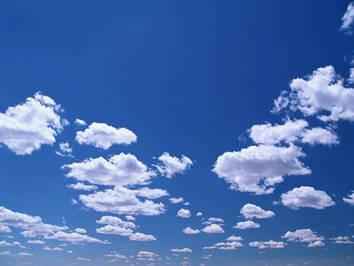(单词翻译:单击)
Look at various parts of the sky on a clear day and you will see that it is not a uniform blue.
抬头仰望天空,你会发现在晴朗的日子里,天空并不会呈现出统一的蓝色。
Even if the sky is deep blue when you look straight up, near the horizon it is lighter.
即使你头顶上正对的这片天是深蓝色的,靠近地平线处的也会相对较浅一些。
This is partly due to pollution, but even in the cleanest air the sky is lighter near the horizon due to the effect of earth's atmosphere on sunlight.
部分原因要归咎于污染,但是就算是在最干净的空气中,贴近地平线处的天空颜色也会比较浅,这是由于地球大气层对阳光的影响。

When the rays of sunlight enter the atmosphere,the atmosphere tends to deflect the light from its straight-line path from the sun to the earth, and spread it around the sky, a process that is called scattering.
当太阳光线进入到大气层时,大气层会使阳光直行进入的路线产生偏离,并使光线散布于天空中,这个过程就叫做散射。
If all the colors were spread equally the sky would look white, since all of the colors of light combined make white light.
如果所有颜色的光线都均匀分散开来,那么天空看上去就会是白色的,因为所有颜色的光线组合起来就是白光。
But the atmosphere does not spread all colors equally in all parts of the sky, and that is why the sky is not a uniform color.
但是大气层不会把所有颜色的光线均匀分布在整个天空中,这就是为什么天空看上去不是统一的颜色的原因。
The color that is most readily spread is blue.
最容易发生散射的是蓝色的光。
So when we look up on a clear day we see blue sky,since the sunlight has had to pass through the least atmosphere, and fewer of the other colors of light have been spread.
由于阳光能够穿透最薄的大气层,并且只有少量颜色的光会发生散射,因此在晴朗的天气里,我们看到天空呈现出的就是蓝色。
However, closer to the horizon the sunlight must pass through more of the atmosphere before it reaches our eyes.
然而,在越靠近地平线的地方,阳光在进入我们的视野之前必须要穿过的大气层也就越厚。
This gives the rays of other colors of light a chance to be spread so that the light reaching our eyes is more a mixture of all the colors and therefore appears lighter.
这就为其他颜色的光发生散射提供了机会。这样一来,进入我们视线的阳光就更像是所有颜色的光的混合体,因此会看上去会比较浅一些。


